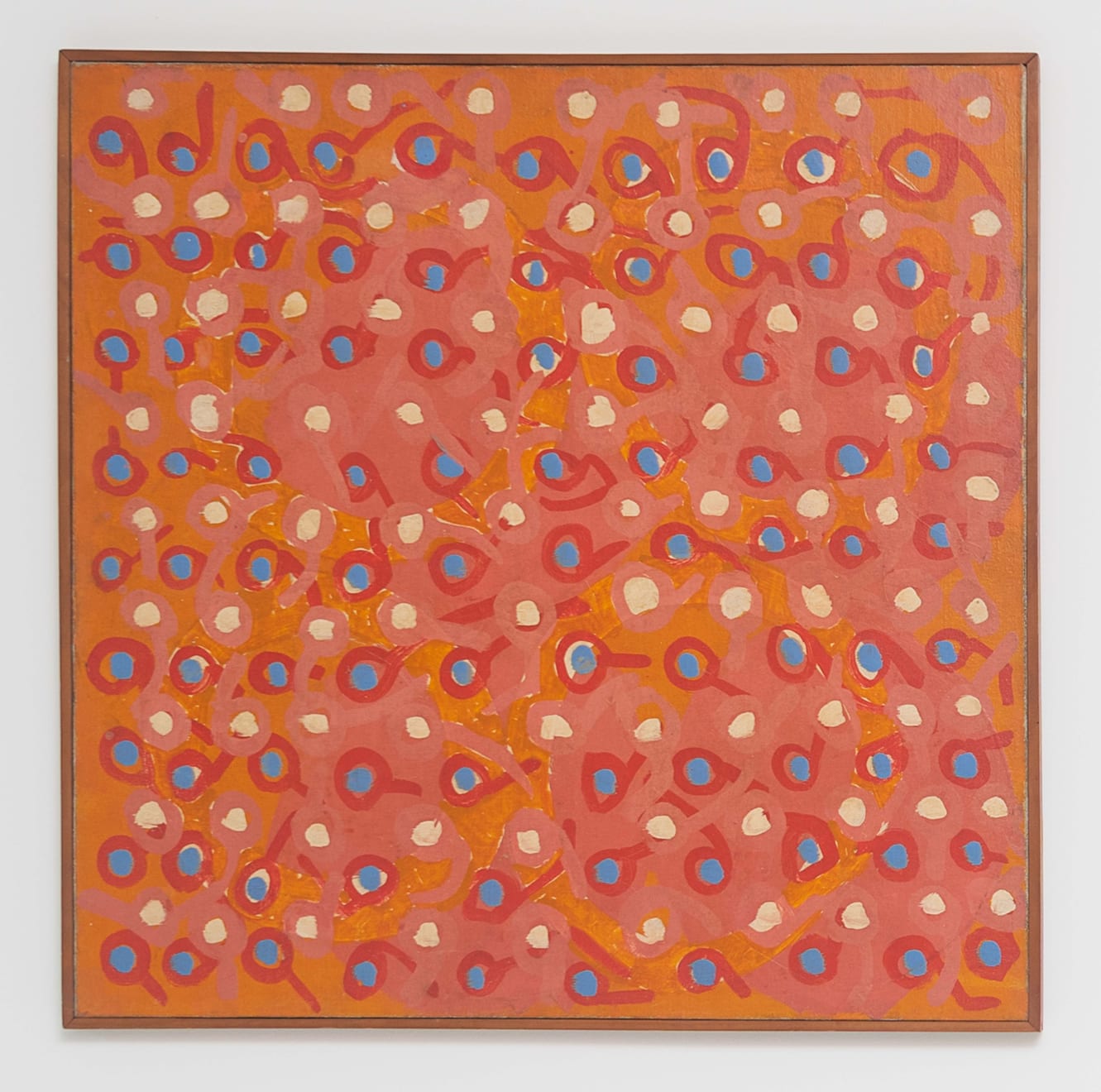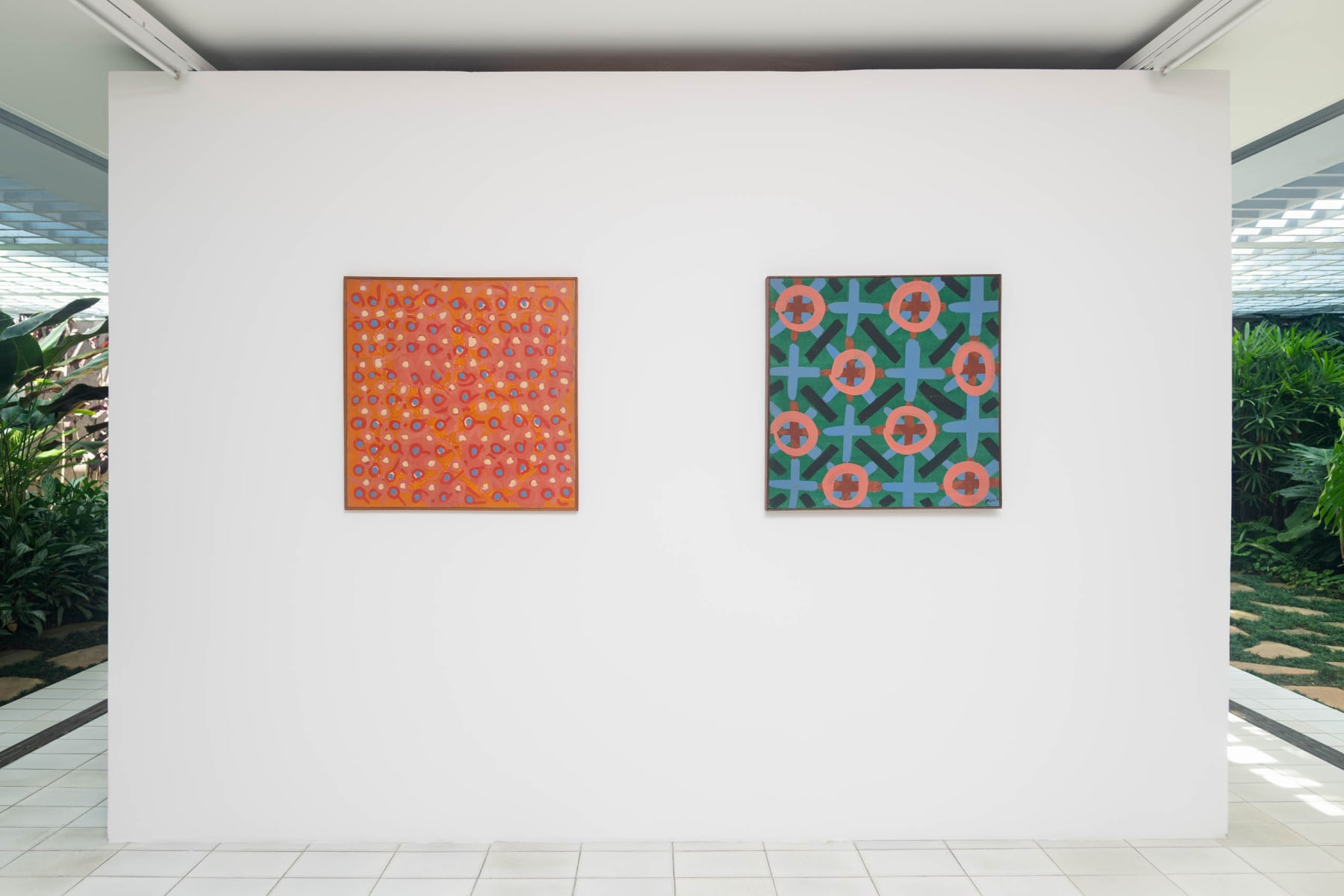-
Waldemar Cordeiro
Sem título | Untitled, 1960óleo sobre tela | oil on canvas75 x 75 cm | 29.53 x 29.53 inWaldemar Cordeiro foi uma das figuras mais importantes para a instauração da Arte Concreta, movimento de vanguarda fundamental para transição da Arte Moderna para a contemporaneidade, o que viria a definir a arte brasileira do século 20. Além de ser pioneiro na arte de computador ainda no final da década de 1960, Waldemar Cordeiro desenvolveu e implementou projetos paisagísticos importantes no Brasil. Em sua pesquisa interdisciplinar, defendia a pintura em sua essência, com linhas e cores básicas que se sustentavam por si só, sem o respaldo da representação figurativa. Primava por uma arte objetiva e racional, muito associada aos seus estudos teóricos, além da investigação de materiais e elementos industriais. Waldemar Cordeiro trabalhava por uma arte acessível a todos, buscando um senso coletivo que se alinhava também à tecnologia, design e ao paisagismo. Sua pesquisa na arte sempre esteve associada a uma preocupação social e política.Waldemar Cordeiro was a key figure in the development of concrete art, a vanguard movement essential for the transition of modern art to contemporary art, which came to define 20th-century Brazilian art. Besides being a pioneer in computer art as early as the 1960s, Waldemar Cordeiro developed and implemented important landscaping designs in Brazil. In his interdisciplinary research he defended painting in its essence, with self-supporting basic colors and lines, without the backing of figurative representation. He was notable for his objective and rational art, very much associated to his theoretical studies, as well as for his investigation of industrial materials and elements. Cordeiro worked for an art accessible to all, seeking a collective sense that was also aligned with technology, to design and to landscaping. His research in art was always coupled with a social and political concern.
Waldemar Cordeiro studied at the Academy of Fine Arts of Rome (1938) and at the Tasso Lyceum of Rome (1945). In 1949, he took up residence in Brazil. He participated in the inaugural show of the Museu de Arte Moderna of São Paulo (MAM-SP), Do figurativismo ao abstracionismo (1949), and in the 1st Bienal de São Paulo (1951). He was also one of the organizers of the show Ruptura, also at MAM-SP (1952), and of Arteônica, at Fundação Armando Alvares Penteado, FAAP-SP (1971). Solo shows of his work have been held at noteworthy venues, including MAM-RJ/SP, CCSP, Buffalo University (USA), MAC-SP, Itaú Cultural, São Paulo, and the Paço Imperial, Rio de Janeiro. Group shows featuring his work have been held at important venues which include the Walker Art Center (USA), the Pinacoteca de São Paulo, the Museum of Fine Arts Houston (USA), the Museum of Modern Art (MoMA), New York (USA), CCBB-SP/RJ, Goethe-Institut, New York (USA), the Museo Nacional Centro de Arte Reina Sofía, Madrid (Spain), Instituto Tomie Ohtake, São Paulo, the Bienal de São Paulo (2012, 1975, 1973, 1969, 1967, 1965, 1963, 1961, 1959, 1957, 1955, 1953 and 1951), and the Biennial of Nuremberg (Germany). Waldemar Cordeiro’s works figure in many prominent collections, including those of the Cisneros Fontanals Art Foundation (USA), the Museu de Arte Contemporânea of the University of São Paulo, the Patricia Phelps de Cisneros Collection (USA), the Pinacoteca de São Paulo, the Museum of Modern Art (MoMA) of New York (USA), the Museum of Fine Arts, Houston (USA), and ZKM Museum (Germany).
Waldemar Cordeiro foi uma das figuras mais importantes para a instauração da Arte Concreta, movimento de vanguarda fundamental para transição da Arte Moderna para a contemporaneidade, o que viria a definir a arte brasileira do século 20. Além de ser pioneiro na arte de computador ainda no final da década de 1960, Waldemar Cordeiro desenvolveu e implementou projetos paisagísticos importantes no Brasil. Em sua pesquisa interdisciplinar, defendia a pintura em sua essência, com linhas e cores básicas que se sustentavam por si só, sem o respaldo da representação figurativa. Primava por uma arte objetiva e racional, muito associada aos seus estudos teóricos, além da investigação de materiais e elementos industriais. Waldemar Cordeiro trabalhava por uma arte acessível a todos, buscando um senso coletivo que se alinhava também à tecnologia, design e ao paisagismo. Sua pesquisa na arte sempre esteve associada a uma preocupação social e política.Waldemar Cordeiro estudou na Academia de Belas Artes de Roma (1938) e no Liceu Tasso de Roma (1945). Em 1949, estabeleceu-se no Brasil. Participou da mostra inaugural do Museu de Arte Moderna de São Paulo “Do figurativismo ao abstracionismo” (1949), além da I Bienal de São Paulo (1951). Foi ainda um dos organizadores da mostra “Ruptura”, também no MAM-SP (1952) e “Arteônica”, na Fundação Armando Alvares Penteado, FAAP-SP (1971). Dentre as principais exposições individuais, estão as do MAM-RJ/SP (Brasil), CCSP (Brasil), Buffalo University (EUA), MAC-SP (Brasil), Instituto Itaú Cultural, São Paulo (Brasil) e Paço Imperial, RJ (Brasil). Dentre as mostras coletivas, estão The Walk Art Center (EUA), Pinacoteca do Estado de São Paulo (Brasil), The Museum of Fine Arts Houston (EUA), Museum of Modern Art, MoMA, NY (EUA), CCBB, SP/RJ (Brasil), Goethe-Institut, NY (EUA), Museo Nacional Centro de Arte Reina Sofia, Madri (Espanha), Instituto Tomie Ohtake, SP (Brasil), Bienal de São Paulo (2012, 1975, 1973, 1969, 1967, 1965, 1963, 1961, 1959, 1957, 1955, 1953 e 1951 edições), Bienal de Nuremberg (Alemanha), etc. As obras de Waldemar Cordeiro estão presentes em coleções como a Fundação de Arte Cisneros Fontanals (EUA), Museu de Arte Contemporânea da Universidade de São Paulo (Brasil), Coleção Patrícia Phelps de Cisneros (EUA), Pinacoteca do Estado de São Paulo (Brasil), Museum of Modern Art, MoMA (EUA), The Museum of Fine Arts, Houston (EUA), ZKM Museum (Alemanha) , dentre outros.



